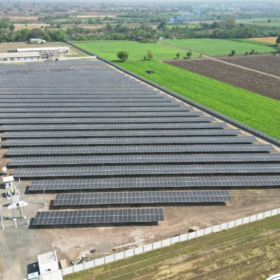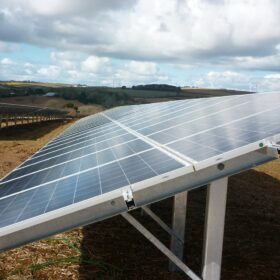A crucial element in combating climate change is the transition to renewable energy sources like solar electricity. Although solar technology has advanced significantly, more work is needed before it can compete effectively with fossil fuels. Employing novel materials might hold the key.
Today, and thus far, silicon makes up the largest number of solar panel semiconductors. However, silicon has a low efficiency, which generally doesn’t exceed 25% for the most popular panels. Cost is also a problem. It is also no secret that the extreme heat needed to remove impurities from silicon makes the process of creating solar panels cumbersome, which is why researchers and businesses have been seeking alternatives.
Perovskite solar cells are a promising technology that offers easy production and highly effective photovoltaics.
This breakthrough material has the potential to produce more solar energy at costs significantly lower than those of conventional silicon PV cells. The expense of laminating a perovskite layer onto the glass of solar panels might be kept to a minimum.
Perovskite is a potential material for improving solar power efficiency because of its low cost and unique features. According to the producers, it is almost ready for commercial application. Perovskites, however, have so far necessitated a lot of testing and trial-and-error, and no application has progressed to the point of commercialization.
Manufacturing
Today’s commercially accessible silicon solar panels typically have 18 to 22% efficiency. However, a single perovskite panel has the potential to produce efficiencies that are close to 33%. And the efficiency can be raised even higher, possibly to above 40%, by manufacturing perovskites that are sensitive to various wavelengths of solar radiation and stacking them to form a tandem cell.
Perovskites are theoretically less expensive to make in large quantities than silicon solar cells because they are intrinsically better at capturing sunlight than silicon. These can be produced at low temperatures using inexpensive and easily accessible materials with much less energy. On the other hand, silicon must be purified from quartz in furnaces at a high temperature.
The opportunity exists for manufacturers to explore a range of low-cost methods for depositing perovskites on a horizontal beam, such as a sheet of glass, to convert that surface into a translucent solar cell. This would include roll-to-roll manufacturing processes like those used in paper and digital printing and perovskite-based aerosols.
Perovskite increases solar panels’ efficiency by widening the silicon components’ energy gap. According to research, the ideal material for solar panels ought to have a band gap of 1.4 electron volts, enabling it to absorb the most photons from solar radiation. With a bandgap of approximately 1.1 eV, silicon is an excellent but not ideal element.
The bandgap of the silicon can be increased by including a fine coating of perovskite which will be able to absorb additional photons, even higher-energy ones, even though it won’t precisely reach 1.4 eV. Perovskite solar cells are more effective because more photons convert into more energy.
Manufacturing perovskite crystals is also easy, typically requiring only inexpensive salt solutions. Additionally, mass-producing perovskite solar cells may be less expensive.
These advantages of perovskite solar cells will translate into increasing accessibility, affordability, and efficiency of solar energy. Consumers and businesses that care about the environment could switch to renewable energy without making a big investment. The increased efficiency would finally allow processes with high power density to rely on renewable energy sources.
Roadblocks
Despite all the benefits, perovskite solar power hasn’t yet gained mainstream acceptance as perovskite is still not a material that’s perfected. Perovskite’s instability is a significant issue under certain ambient conditions. Plus, solar panels require mounting brackets using durable metal components. Due to its thin crystalline structure, perovskite might not be robust enough for such uses.
Perovskite solutions frequently dissolve in water and are less heat-resistant than silicon. When exposed to direct sunshine, a solar panel’s surface can reach 71-72 degrees Celsius. At this temperature, the ions begin to migrate fast, deteriorating the molecular structure of the materials. As a result, perovskite solar cells may not maintain their efficiency for very long.
The presence of lead in the most effective perovskite cells is another possible source of worry. Manufacturers would need to exercise extreme caution to make sure that none of this poisonous metal spills into the environment or puts workers in danger. Any perovskite solar panel that contains lead is ineligible for use in single-use items.
Way forward
Perovskite solar cells still need to overcome a number of obstacles before they find widespread application.
On an optimistic note, tremendous headway has been made in a recent study. Enclosing the perovskite in glass or plastic reduces its susceptibility to heat and humidity. New compounds can be added to strengthen the perovskite framework and make it more resistant to structural changes brought on by heat and moisture. If present trends persist, we may soon have perovskite panels that are reliable, effective, and long-lasting.
The views and opinions expressed in this article are the author’s own, and do not necessarily reflect those held by pv magazine.
This content is protected by copyright and may not be reused. If you want to cooperate with us and would like to reuse some of our content, please contact: editors@pv-magazine.com.








By submitting this form you agree to pv magazine using your data for the purposes of publishing your comment.
Your personal data will only be disclosed or otherwise transmitted to third parties for the purposes of spam filtering or if this is necessary for technical maintenance of the website. Any other transfer to third parties will not take place unless this is justified on the basis of applicable data protection regulations or if pv magazine is legally obliged to do so.
You may revoke this consent at any time with effect for the future, in which case your personal data will be deleted immediately. Otherwise, your data will be deleted if pv magazine has processed your request or the purpose of data storage is fulfilled.
Further information on data privacy can be found in our Data Protection Policy.